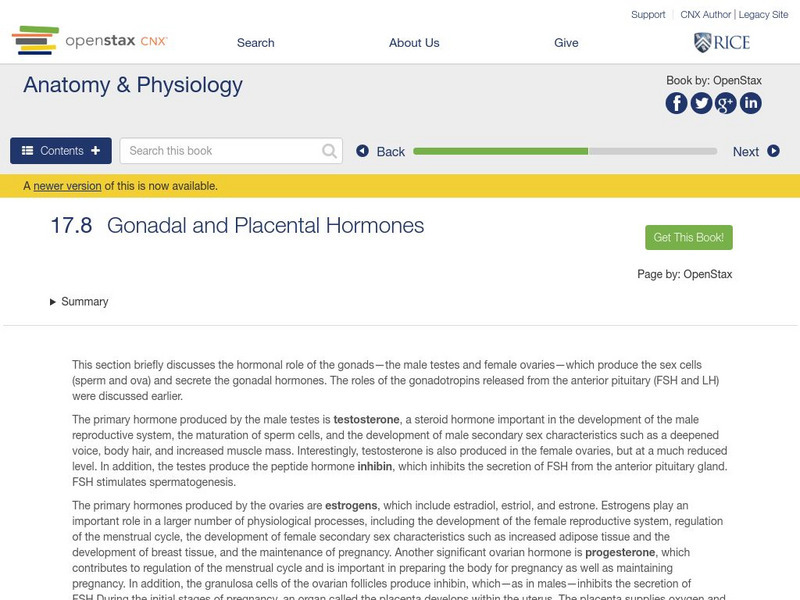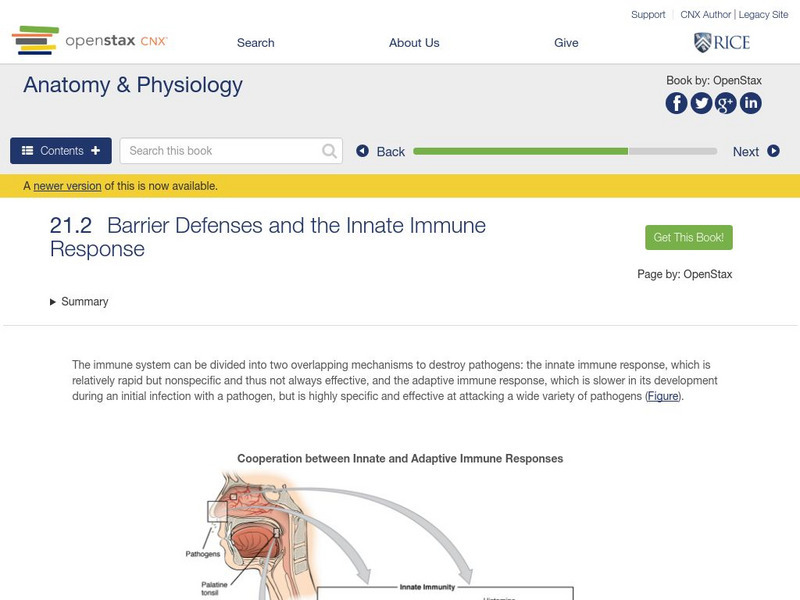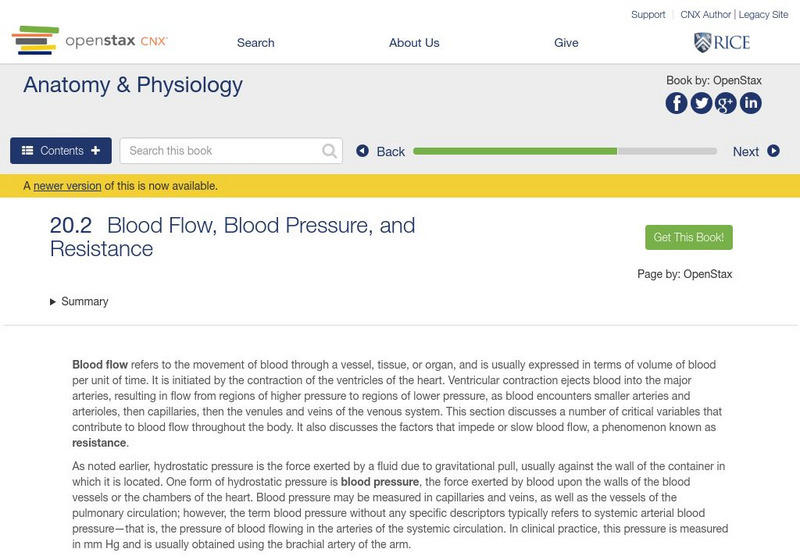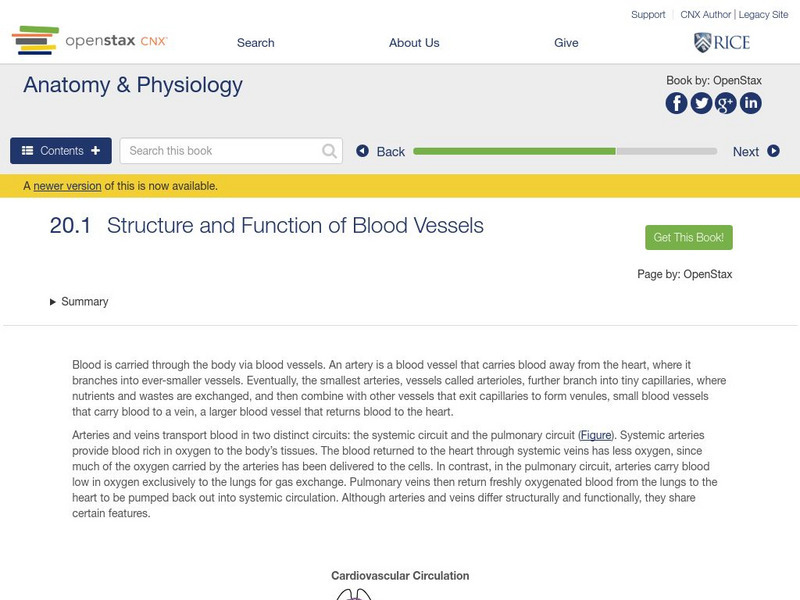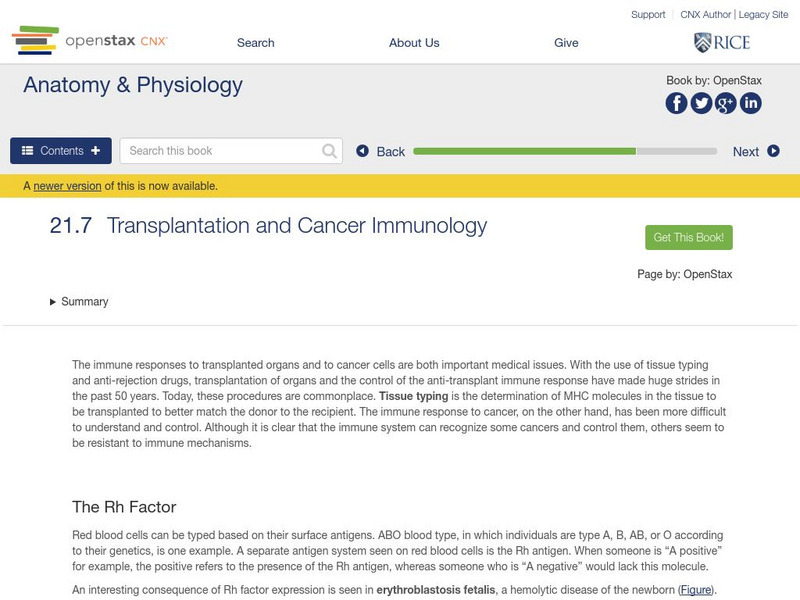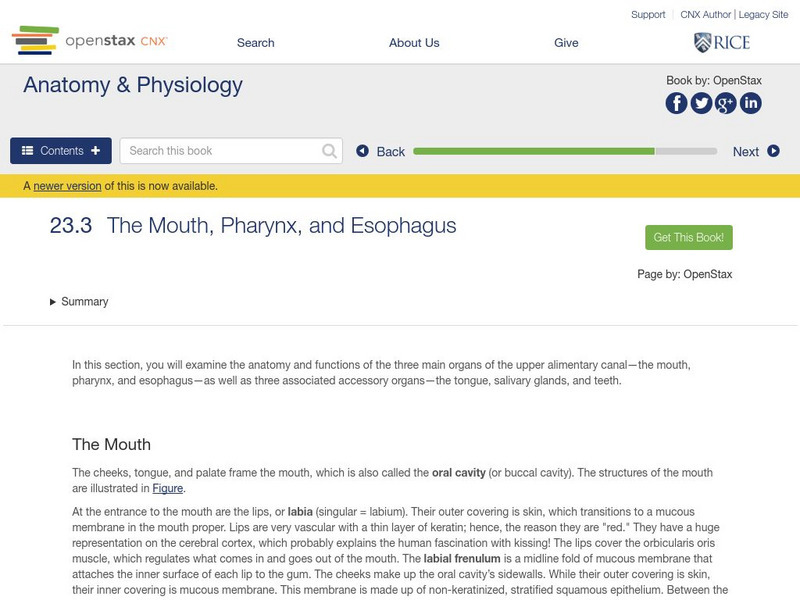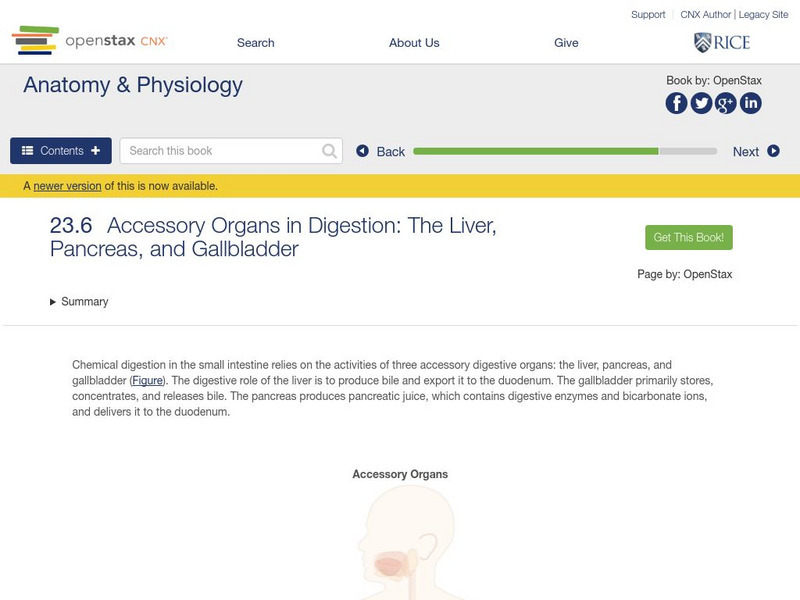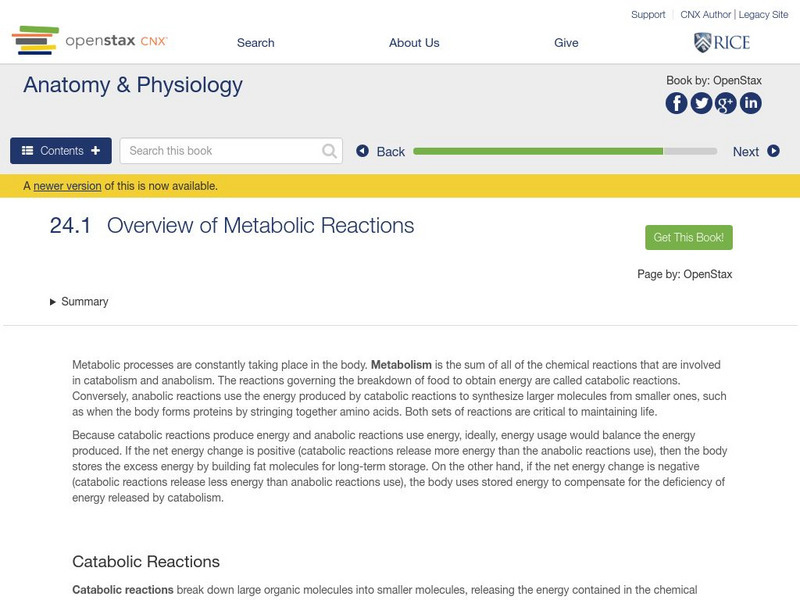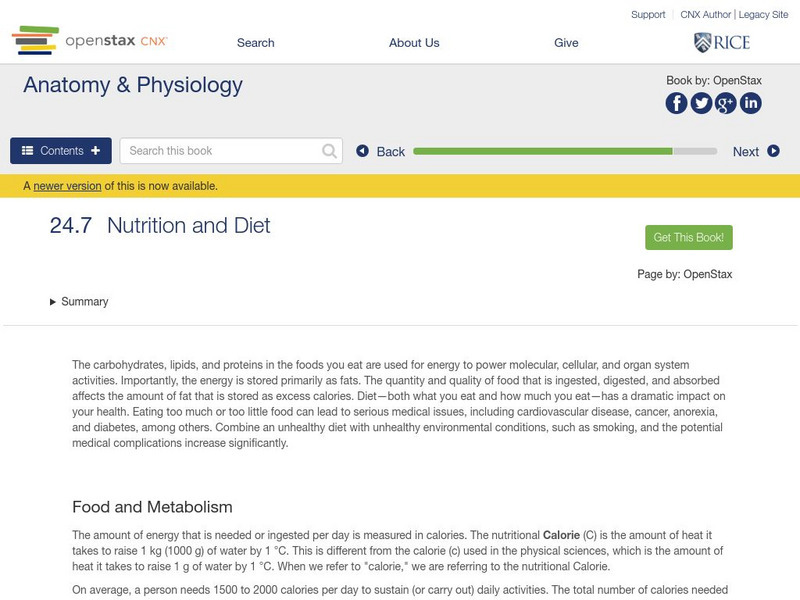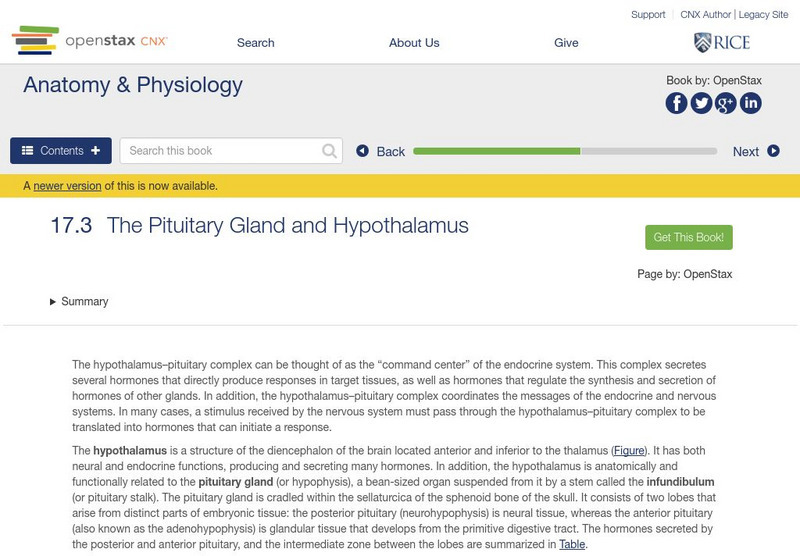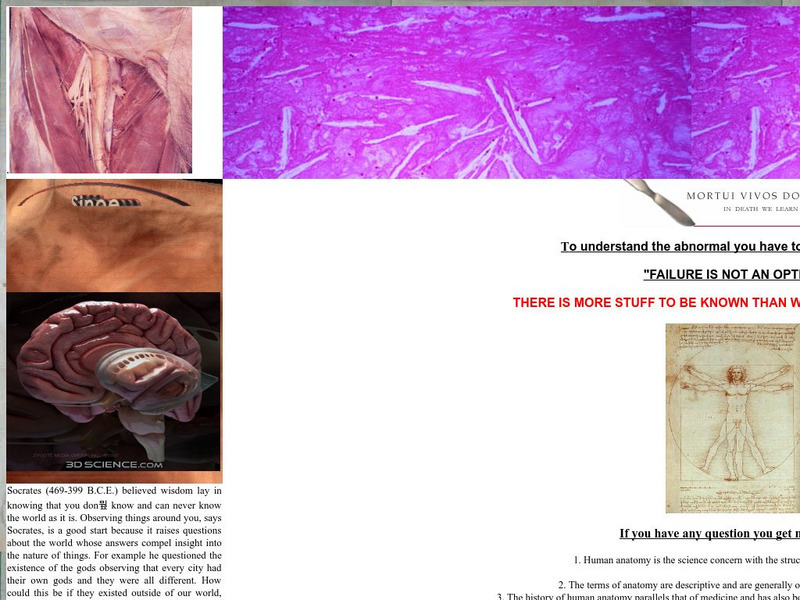OpenStax
Open Stax: Anatomy & Physiology: The Cranial Nerve Exam
Students learn about the functional grouping of cranial nerves and match the regions of the forebrain and brain stem that are connected to each cranial nerve.
OpenStax
Open Stax: Anatomy & Physiology: Water Balance
Learn how water levels in the body influence the thirst cycle and body fluid regulation. Find out about dehydration and identify common causes of dehydration.
OpenStax
Open Stax: Anatomy & Physiology: Gonadal and Placental Hormones
Students will identify the most important hormones produced by the testes and ovaries, and learn about the hormones produced by the placenta.
OpenStax
Open Stax: Anatomy & Physiology: Adaptive Immune Response: B Lymphocytes
Students will learn the structure and function of B-cells and the antibody classes and their functions.
OpenStax
Open Stax: Anatomy & Physiology: Barrier Defenses and Innate Immune Response
Students use this module to learn about the barrier defenses and the immune defense functions of the human body.
OpenStax
Open Stax: Anatomy & Physiology: Blood Flow, Blood Pressure, and Resistance
Learn about the components and measurement of arterial blood pressure, as well as the variables affecting blood flow and blood pressure in this learning exercise.
OpenStax
Open Stax: Anatomy & Physiology: Chemical Digestion/absorption: A Closer Look
In this module, find out the locations and primary secretions involved in the chemical digestion of carbohydrates, proteins, lipids, and nucleic acids.
OpenStax
Open Stax: Anatomy & Physiology: Energy and Heat Balance
Learn how the human body regulates temperature and explain the significance of the metabolic rate.
OpenStax
Open Stax: Anatomy & Physiology: Structure and Function of Blood Vessels
Learn the structure and function of the blood vessels of the human cardiovascular system.
OpenStax
Open Stax: Anatomy & Physiology: Transplantation and Cancer Immunology
Students discover how blood typing affects transfusions and organ transplants. They will also learn how the immune response is able to control some cancers.
OpenStax
Open Stax: Anatomy & Physiology: The Mouth, Pharynx, and Esophagus
Describe the structures of the mouth, including its three accessory digestive organs: the mouth, pharynx, and esophagus. Also trace the pathway food follows from ingestion into the mouth through release into the stomach.
OpenStax
Open Stax: Anatomy & Physiology: Regulation of Renal Blood Flow
Students learn about the myogenic and tubuloglomerular feedback mechanisms, and explain how they affect urine volume and composition.
OpenStax
Open Stax: Anatomy & Physiology: Liver, Pancreas, Gallbladder
Students learn about the main digestive roles of the liver, pancreas, and gallbladder, and identify three main features of liver histology that are critical to its function.
OpenStax
Open Stax: Anatomy & Physiology: Overview of Metabolic Reactions
Students discuss the role of polymers, monomers, and ATP in metabolism, and then describe the hormones that regulate anabolic and catabolic reactions.
OpenStax
Open Stax: Anatomy & Physiology: Nutrition and Diet
Explain how different foods and eating a healthy diet can affect a person's metabolism. Also learn reasons why vitamins and minerals are critical to a healthy diet.
OpenStax
Open Stax: Anatomy & Physiology: Maternal Changes During Pregnancy and Birth
Students learn about the changes that happen in a woman's body during pregnancy, labor, and delivery of a baby.
OpenStax
Open Stax: Anatomy & Physiology: Patterns of Inheritance
Students learn about patterns of inheritance including genotype and phenotype, and then learn about the inheritance of autosomal dominant and recessive and sex-linked genetic disorders.
OpenStax
Open Stax: Anatomy & Physiology: The Sensory and Motor Exams
Students learn the arrangement of sensory and motor regions in the spinal cord in order to understand a sensory and motor exam. They will also understand the clinical indications of common reflexes.
OpenStax
Open Stax: Anatomy & Physiology: The Pituitary Gland and Hypothalamus
Learn about the hormones released by the pituitary gland, their target cells, and their principal actions, as well as the structure and function of the hypothalamus.
OpenStax
Open Stax: Anatomy & Physiology: The Coordination and Gait Exams
Students learn about the relationship between the location of the cerebellum and its function in movement in order to understand the processes of coordination and gait exams.
OpenStax
Open Stax: Anatomy & Physiology: Leukocytes and Platelets
This study of white blood cells includes informational reading material, illustrated diagrams, vocabulary, and self-checking review and application questions.
OpenStax
Open Stax: Anatomy & Physiology: Body Fluids and Fluid Compartments
Learn about the chemical and physical characteristics of the fluids that make up the human body.
OpenStax
Open Stax: Anatomy & Physiology: Development of the Heart
Study the embryological development of heart structures including the five regions of the fetal heart with these learning exercises.
Other
Danil Hammoudi, Md: Anatomy and Physiology Course
This page has complete course material for a beginning human anatomy course and everything can be downloaded. There are readings and presentations on all the major systems and organs of the human body, with lots of detailed, labeled...
Other popular searches
- Heart Anatomy and Physiology
- Anatomy and Physiology Web
- Plant Anatomy and Physiology
- Basic Anatomy and Physiology


